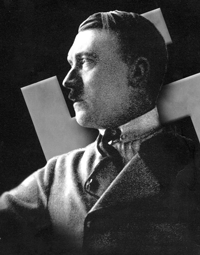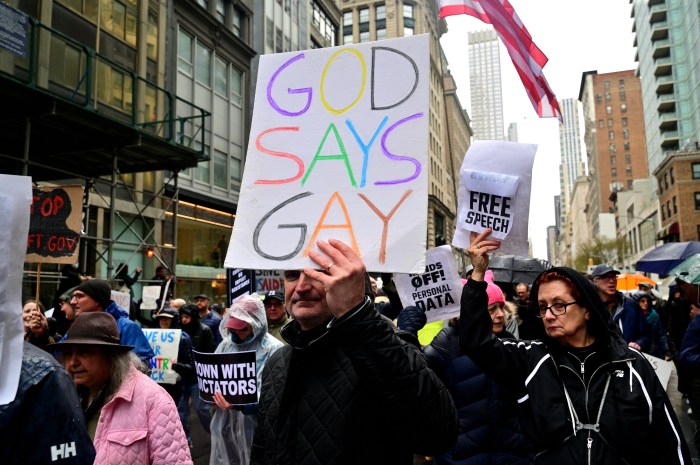World of Wonder fails to improve on a shaky book on the fuhrer’s sexuality
World of Wonder, a Hollywood-based film production company, has in the dozen years of its existence built a remarkably diverse and provocative library of dozens of movies on gay themes and aimed at gay audiences. It tackled club kid murderer Michael Alig twice––first in “Party Monster, the Shockumentary” and more recently in “Party Monster, the Movie.” “The Eyes of Tammy Faye” chronicled––and, in no small measure, contributed to––the rehabilitation of disgraced televangelist Jim Bakker’s former wife into a gay icon. In “Out of the Closet and Off the Screen,” based on William J. Mann’s biography of gay silent film giant William Haines, WOW proved its commitment to documenting history that otherwise might have been forgotten.
Next Tuesday, on Cinemax, WOW premieres its latest historical venture––this time, unfortunately, with considerably less distinction.
“The Hidden Fuhrer,” based on the 2001 book “The Hidden Hitler,” by Lothar Machtan, an historian from Germany’s Bremen University, purports to “debate[e] the enigma of Hitler’s sexuality”––specifically Machtan’s contention that the leader of Nazi Germany was a closeted homosexual.
The film acknowledges that many will find investigations into Hitler’s possible homosexuality unnerving and perhaps even inappropriate, particularly if his orientation were linked to his monstrous historical crimes. Michael Bronski, the longtime gay writer, is shown concluding that, after much thought, he believes that the question is “irresponsible.”
But that is not the film’s failing, and the suggestion that objections to its contents are based primarily on an unwillingness to look at the question sets up a straw horse of sorts. “The Hidden Fuhrer” doesn’t go too far; in fact, it doesn’t go far enough. Rather than truly engage a debate about Hitler’s sexuality, and perhaps even explore the link between his sexuality and his ideology, the film instead rather mechanically runs through a checklist of Machtan’s specific assertions, and provides a point/counterpoint back and forth between the author and his critics, most often Geoffrey Giles, a Hitler scholar who has written extensively about sexuality and homosexuality in the Third Reich, including work for the research institute at the United States Holocaust Museum in Washington.
At the start of “The Hidden Fuhrer,” the narrator notes that few scholars have endorsed Machtan’s conclusions. Writing at the time the book was published, Alan Bullock, the British historian who wrote the seminal “Hitler: A Study in Tyranny” in 1952, said that “The Hidden Hitler” lacked sufficient evidence to judge its merits. Yet, for all the time Giles is given in the film, he is never offered a chance to lay out a comprehensive critique of the quality of Machtan’s scholarship.
In fact, Machtan’s work is problematic. Right from the start, the book is explicitly argumentative, and he often resorts to tortured twists in buffering his case. When evidence is missing, it is because Hitler destroyed it. When evidence of Hitler’s homophobia is addressed, we learn that Hitler was simply protesting too much. Sweeping conclusions about Hitler’s personal life and personal actions are based on the argument that nothing else could explain the fact pattern, even when the data is sketchy at best.
The filmmakers––directors Randy Barbato and Fenton Bailey and producer Gabriel Rotello––appeared this week at a screening of the film at HBO’s midtown headquarters and talked about how they judged Machtan’s success at meeting his burden of historical proof. Rotello, who served as editor of the late-80s Manhattan gay newspaper Outweek and in 1997 wrote “Sexual Ecology,” a major study of AIDS epidemiology in the gay community, was clearly the most comfortable of the three addressing the underlying historiographic issues.
“People [in the gay community] look at historical figures from Leonardo da Vinci to Michelangelo to Eleanor Roosevelt, [and] we tend to read between the lines of the kind of work they accomplished and the letters that they wrote, and if there’s any kind of plausible case to be made that they are homosexual, somebody writes a book to that effect, and they will then be brought into the fold of gay historical figures and, from now on, we will say Leonardo da Vinci is gay or Eleanor Roosevelt is a lesbian, whereas with Adolph Hitler it seems to me that the opposite happened,” Rotello argued. “Machtan has found considerably more evidence that we’ve usually found about people like that––not proof–– but he found considerably more evidence than is usually found and yet even with that evidence, there was tremendous resistance often by the same folk in the gay world who are the very first to champion the idea that other ‘good’ historical figures are gay or lesbian.”
Without the sort of inference that lies at the heart of Machtan’s book and much of the work about the supposed homosexual lives of others from the past, Rotello argued, “there goes gay history, because the only way we can reclaim our history is to look at the kinds of hints and suggestions left behind by historical figures.”
Without commenting on Rotello’s estimation of the quality of other historical accounts of closeted or quiet gay lives, it is fair to argue that he is overselling Machtan’s work.
Among the most provocative information presented in Machtan’s book is testimony that Hans Mend, a fellow soldier of Hitler’s in World War I, offered to the German resistance in the late 30s. In that testimony, Mend alleged that it was common knowledge among Hitler’s wartime comrades that he was a homosexual. Machtan argued that with this knowledge, Mend posed a threat to Hitler throughout the 30s that led to intermittent harassment by the Nazis and eventually imprisonment in a concentration camp and death.
Machtan did not, however, fully acknowledge Mend’s own credibility problems. Clearly, he was a shifty character eager to cash in on his long relationship with Hitler. Machtan argued that he was able to successfully bribe Hitler through the ‘30s. But, he was less successful in explaining why Hitler allowed the Nazis to recruit him to write a propaganda biography of Hitler’s life. It is also a puzzle why Hitler, who was using murder as an ordinary tool of government as early as 1933, waited until 1940 to put away a man as presumably dangerous to him as Mend.
Ron Rosenbaum, author of “Explaining Hitler,” appears in the film and offers the best succinct appraisal of Mend––if he were to appear on the stand in a criminal trial, he would not make a very credible witness.
Machtan also relied on a 1949 account by Eugen Dollman, a Nazi intelligence officer who served Hitler personally as a translator, that said that a high ranking military officer had Munich police files from the early 20s in which informants identified Hitler as homosexual. Dollman, who lived until 1980, was never questioned about these claims by historians. Machtan is unable to provide any back up documentation for the very specific assertions Dollman made almost 30 years after they presumably first surfaced.
Beyond these two sources, Machtan spent much time examining other “suspicious” chapters in Hitler life –– his relationship to Ernst Röhm, the homosexual head of the SA who Hitler had killed off in a bloody purge in 1933, his troubled relationships with his suicidal niece Geli Raubal (who merited eight pages) and with Eva Braun (who got only two pages!), and youthful relationships with two men. None of these discussions was truly satisfying in terms of understanding Hitler’s inner life, and the WOW film has little to add on these matters.
One of the few departures in new research provided by the film involves allegations that Hitler, who had an intimate relationship with the descendants of his hero, the opera master Richard Wagner, molested an underage male in the family. Unfortunately, that section of the film offers insufficient detail to evaluate the claims.
Machtan’s discussion of two friendships of Hitler’s while he was a young man in Vienna and later Munich was particularly troubling. Throughout, Machtan emphasized that Hitler lived in men’s hotels (which early homosexual advocate Magnus Hirschfeld identified as hotbeds of homosexual activity), that all three men were close to their mothers, and that all were devotees of Wagner. The author’s argument that all of these characteristics of homosexual life were identified in Hirschfeld’s writings does not alter the fact that they are slender stereotypes on which to draw broad conclusions.
Even while repeating those stereotypes, the film also includes an extended exposition of the theory that once he came to power in Germany, Hitler was forced to end his active sexual life and sublimate his feelings into an almost obsessive concern with art and architecture. The film goes so far as to hint of an erotic connection between the fuhrer and his master builder, Albert Speer.
When one commentator likens Hitler’s choice of Leni Riefentahl to direct his propaganda film about the 1934 Nazi Party conference in Nuremberg, “Triumph of the Will,” to George W. Bush engaging Bruce Webber, “The Hidden Fuhrer” veers uncomfortably close to camp. Yet, as with the early shots of shirtless, hairless buff Hitler Youth, the point is clear––the assumption that Hitler is gay has become the narrative default, notwithstanding Rotello’s flat statement that he is “not even convinced” that the theory is true.
One final, indeed overarching issue, that Rotello addressed this week at HBO was why the issue of Hitler’s sexuality is important at all. Above all the other arguments about the ways in which sexuality and personal biography have come to the fore in modern historiography, he located the significance of this issue first and foremost in the fact that prior to the rise of the Nazis, Germany had the world’s first and leading homosexual emancipation movement, one Rotello said was as advanced as the U.S. movement of the late 1970s.
“If it’s true that [Hitler] was [gay] and if it’s true that he snuffed out the only gay liberation movement in existence and set it back by 50 years and that the destruction of that movement was caused by a closeted gay person who was attempting to cover up his own homosexuality, that to me is one of the most frightening and horrifying and, from an historical perspective, profound things that we can possibly imagine,” he argued. “I can hardly imagine anything in gay history that could be more important than that.”
Asked what link there might be between Hitler’s homosexuality and his anti-Semitism, Rotello said, “I don’t know that there is a strong connection,” and argued that Machtan didn’t think so either.
In fact, Machtan was not that careful. Machtan located the earliest public expression of Hitler’s anti Semitism to a scandal that took hold in Germany between 1906 and 1909 resulting from the charges by Maximilian Harden, a Jewish journalist in Vienna, that Philipp, Prinz zu Eulenburg, a close confidante of the German kaiser, was gay. The accusations unleashed a torrent of anti-Semitic rants among German nationalists, but in Machtan’s rather overcomplicated view it hit Hitler particularly hard because it awakened anxieties about his own homosexuality.
“Under the pressure of the spectacular Eulenburg affair, Hitler had clearly worked himself up into something that ultimately led to his furious anti-Semitic onslaughts,” Machtan wrote.
According to Rotello, Machtan was horrified when the media inappropriately hyped claims that the author tied Hitler’s homosexuality to the Holocaust, specifically mentioning a “Today Show” lead-in to an interview by Matt Lauer. Yet in a print ad for the book run in The New York Times in 2001, Basic Books, Machtan’s publisher, asserted the work was “the first book to reveal Hitler’s secret life and its calamitous public consequences.” Not unlike the heavy-handed lavender swastika behind Hitler’s image in the Cinemax promotional material for “The Hidden Fuhrer,” such a marketing gambit was clearly playing with fire.






























